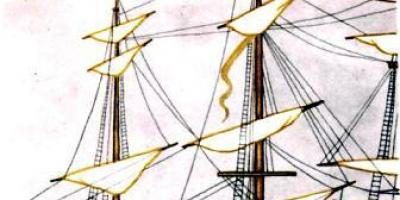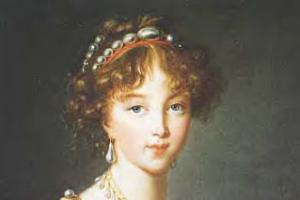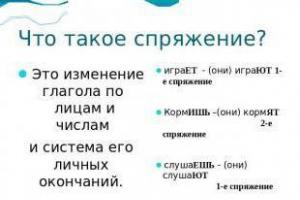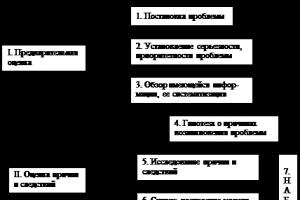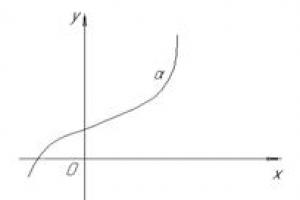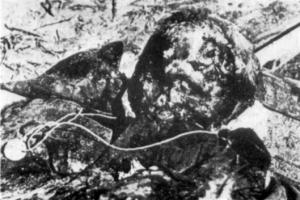
Our ship was anchored off the coast of Africa. It was a beautiful day, a fresh wind was blowing from the sea; but in the evening the weather changed: it became stuffy and, as if from a heated stove, hot air from the Sahara desert was blowing towards us.
Before sunset, the captain went out on deck and shouted: “Swim!” - and in one minute the sailors jumped into the water, lowered the sail into the water, tied it and set up a bath in the sail.
There were two boys with us on the ship. The boys were the first to jump into the water, but they were cramped in the sail, and they decided to race against each other in the open sea.
Both, like lizards, stretched out in the water and, with all their strength, swam to the place where there was a barrel above the anchor.
One boy at first overtook his friend, but then began to fall behind.
The boy's father, an old artilleryman, stood on the deck and admired his son. When the son began to fall behind, the father shouted to him:
- Don't give it away! Push up!
Suddenly someone shouted from the deck: “Shark!” - and we all saw the back of a sea monster in the water.
The shark swam straight towards the boys.
- Back! Back! Come back! Shark! - the artilleryman shouted. But the guys didn’t hear him, they swam on, laughing and shouting even more fun and louder than before.
The artilleryman, pale as a sheet, looked at the children without moving.
The sailors lowered the boat, rushed into it and, bending the oars, rushed as hard as they could towards the boys; but they were still far from them when the shark was no more than twenty steps away. 
At first the boys did not hear what they were shouting and did not see the shark; but then one of them looked back, and we all heard a high-pitched squeal, and the boys swam in different directions.
This screech seemed to awaken the artilleryman. He jumped up and ran towards the guns. He turned his trunk, lay down next to the cannon, took aim and took the fuse.
All of us, no matter how many of us were on the ship, froze in fear and waited for what would happen.
A shot rang out, and we saw that the artilleryman fell near the cannon and covered his face with his hands. We didn’t see what happened to the shark and the boys, because for a minute the smoke obscured our eyes.
But when the smoke dispersed over the water, first a quiet murmur was heard from all sides, then this murmur became stronger, and finally, a loud, joyful cry was heard from all sides.
The old artilleryman opened his face, stood up and looked at the sea.
The yellow belly of a dead shark swayed along the waves. In a few minutes the boat sailed to the boys and brought them to the ship.

- END -
Tolstoy's story L. Illustrations.

Our ship was anchored off the coast of Africa. It was a beautiful day, a fresh wind was blowing from the sea; but in the evening the weather changed: it became stuffy and, as if from a heated stove, hot air from the Sahara desert was blowing towards us.
Before sunset, the captain went out on deck and shouted: “Swim!” - and in one minute the sailors jumped into the water, lowered the sail into the water, tied it and set up a bath in the sail.
There were two boys with us on the ship. The boys were the first to jump into the water, but they were cramped in the sail, and they decided to race against each other in the open sea.
Both, like lizards, stretched out in the water and, with all their strength, swam to the place where there was a barrel above the anchor.
One boy at first overtook his friend, but then began to fall behind.
The boy's father, an old artilleryman, stood on the deck and admired his son. When the son began to fall behind, the father shouted to him:
- Don't give it away! Push up!
Suddenly someone shouted from the deck: “Shark!” - and we all saw the back of a sea monster in the water.
The shark swam straight towards the boys.
- Back! Back! Come back! Shark! - the artilleryman shouted. But the guys didn’t hear him, they swam on, laughing and shouting even more fun and louder than before.
The artilleryman, pale as a sheet, looked at the children without moving.
The sailors lowered the boat, rushed into it and, bending the oars, rushed as hard as they could towards the boys; but they were still far from them when the shark was no more than twenty steps away. 
At first the boys did not hear what they were shouting and did not see the shark; but then one of them looked back, and we all heard a high-pitched squeal, and the boys swam in different directions.
This screech seemed to awaken the artilleryman. He jumped up and ran towards the guns. He turned his trunk, lay down next to the cannon, took aim and took the fuse.
All of us, no matter how many of us were on the ship, froze in fear and waited for what would happen.
A shot rang out, and we saw that the artilleryman fell near the cannon and covered his face with his hands. We didn’t see what happened to the shark and the boys, because for a minute the smoke obscured our eyes.
But when the smoke dispersed over the water, first a quiet murmur was heard from all sides, then this murmur became stronger, and finally, a loud, joyful cry was heard from all sides.
The old artilleryman opened his face, stood up and looked at the sea.
The yellow belly of a dead shark swayed along the waves. In a few minutes the boat sailed to the boys and brought them to the ship.

- END -
Tolstoy's story L. Illustrations.
Title of the work: Shark
Number of pages: 1
Genre: story
Main characters: the narrator, two boys, an old artilleryman and a shark.
Characteristics of the main characters:
Artilleryman- dexterous and accurate.
Managed to kill a shark with one shot and save the boys.
boys- they were having fun and swimming, and didn’t even hear that a shark was approaching them.
Summary of the story "Shark" for the reader's diary
On a ship standing off the coast of Africa, it became very hot from the wind blowing from the Sahara Desert.
The captain of the ship allowed the sailors to swim in the bathhouse, near the ship, made of sail.
In addition to the crew, there were also passengers traveling on the ship, two boys and an old artilleryman - the father of one of the boys.
The boys also jumped into the water for a swim, swimming into the open ocean. The captain and an old cavalryman watched the whole action from the deck.
Suddenly a shark appeared and began to approach the children.
The old cavalryman began to shout to the boys about the danger, and the sailors got into the boat and went to save the children.
Only it was all in vain. The boys did not hear the screams, and the sailors were much further from the boys than the shark.
When the boys saw the shark, it was already close, and there was no way to escape from it.
The boys screamed and rushed to swim in different directions.
The squealing of the children brought the old artilleryman out of his stupor. He ran to the guns and shot at the shark.
When the smoke from the shot cleared, everyone saw that the shark was dead.
The old artilleryman saved the boys from the shark with his shot.
Retelling plan:
1. Coast of Africa
2. Captain's instructions
3. Boys' fun
5. Sailors rush to help
6. Children noticed the danger
7. Shot from a cannon
8. Killed shark
Drawing - illustration for the story "Shark".
Sinkwine:
Boys.
Silly, playful.
They swim, play, and are afraid.
Survived danger from a shark.
The main idea of the story "Shark":
Such character traits can save someone's life in an extreme situation.
What does the story teach?
Brief review of the story "Shark" for the reader's diary
The story "Shark" surprised and amazed me.
And I was even more delighted by the artilleryman - one of the heroes of the story.
When the shark approached the boys, he, like everyone else, froze in horror.
But he pulled himself together and responded to the danger in time, thereby saving two children.
This is a brave act.
I learned that in a difficult situation it is important to act quickly and decisively.
But that is not all.
Also in the story "Shark", Leo Tolstoy shows the reader by example that violation of safety rules can lead to tragedy.
After all, the captain, knowing about the danger of sharks, ordered a bathhouse to be built.
If an experienced artilleryman had been able to kill the shark with an accurate shot and save the boys, otherwise everything would have ended very badly.
The excerpt from the story “Shark” that struck me most:
Suddenly someone shouted from the deck: “Shark!” - and we all saw the back of a sea monster in the water.
The shark swam straight towards the boys.
Back! back! come back! shark! - the artilleryman shouted.
What proverbs fit the story “Shark”:
Determination deflects danger
Not recognizing the ford, he threw it into the water
From stupid risk to disaster is close.
Good help at the right time.
Unknown words and their meanings:
Artilleryman - a soldier in the artillery
The gun trunk is the rear part of the gun that rests on the deck.
A wick is a igniting cord for igniting charges.
Deck - the floor of a ship.
Public lesson
in 3 "A" class
MBOU secondary school No. 1
in literary reading
Topic: L.N. Tolstoy. Story “Shark”.
Teacher:
Dutova Marina Mikhailovna
Topic: L.N. Tolstoy. The story "Shark".
Lesson objectives:
continue to get acquainted with the works of Leo Tolstoy;
introduce a short biography of the writer;
develop an understanding of the expressive capabilities of words and speech patterns as a means of conveying the emotional coloring of the text;
develop the ability to analyze text, understand the actions of characters;
fill students’ speech with new words and phrases;
develop meaningful, expressive reading skills.
Equipment:
presentation with a portrait of L.N. Tolstoy, his family estate, etc.; with illustrations for the work;
book exhibition.
2 photos of a shark (A 4): one photo cut into 5 figures;
vocabulary words on cards: deck, sail, anchor, trunk, wick, murmur, gunner; drawings for vocabulary work.
for each row, strips of blue paper (sea), located vertically on the back of the board;
drawings of boats on a magnet according to the number of strips of blue paper;
sails for boats in scarlet and gray colors per child in two colors;
textbookLiterary reading. Grade 3, part 1.
During the classes
Org. moment. Greetings, checking workplaces.
Checking d/z. “The Childhood of Leo Tolstoy” (from the writer’s memoirs).
Frontal survey. Selective reading.
From childhood, what writer did we meet in the last lesson? (portrait - presentation, slides 10-18)
Where was Leo Tolstoy born and spent his childhood?
What does Leo Tolstoy remember about his mother?(read out)
How many children were there in the Tolstoy family?(5 children)
Who was the ringleader in the children's games?(Nikolai)
What else did you find out about him?
What was the secret that was announced
younger Nikolai?(read)
What can you say about this stick?(showing stick)
How did the children feel about all these secrets?
(believed, trembled, with importance)
Summary with a new message:
Lev Nikolaevich spent his childhood and most of his life on the Yasnaya Polyana estate, not far from Moscow and Tula. He was one and a half years old when his mother died, but the warmth of a large and friendly family - first his father, and then his grandmother, aunts, three brothers and a sister - did not give him the opportunity to acutely feel orphanhood. L.N. Tolstoy considered childhood not only the happiest but also the most important time, because it was then that his soul was given a direction, where to grow, what to strive for. Lev Nikolaevich lived a long life and wrote various works. Worked a lot. He revised his works several times, rewrote them 10-12 times to make them good. Tolstoy loved work, he also did peasant work: he plowed the land, mowed grass, sawed and chopped wood, built huts, laid stoves, sewed boots. He believed that all work is useful and necessary; You can only respect a person who works all his life. Tolstoy lived in his house in Yasnaya Polyana for a very long time. Now there is a museum there, which is visited by people from all over the world. In the neighboring village, Lev Nikolaevich tripled the school and began teaching peasant children using textbooks that he wrote himself. More than one generation of children studied using these textbooks.
Self-determination for activity:
You will find out what will be discussed in the lesson if you cope with the tricky task.
(Slides 1-5:
artilleryman – a) military man or b) athlete
canvas - c) low light or d) linen fabric
wick – e) combustible cord for a weapon or f) tropical plant
murmur - g) quiet dissatisfied speech or h) classical music
trunk - i) elongated nose or j) the back of the gun (for this word it is important to say that both interpretations are correct, but only the first word “artilleryman” will prompt the choice)
/ On the board on the left is a cut picture of a shark (5 parts under the letters of the correct dictionary answers: a, d, d, g, j and 5 pieces of paper without a picture/.
Children, find the correct interpretation of the dictionary word by choosing an answer among the two proposed. We will leave the correct answer, and remove the figure with the letter of the incorrect interpretation. (5 figures will remain on the board, which, after turning them over, are put together like puzzles to recreate the shark drawing. The picture will be cut and here you need to replace it with a whole one)
What do you say? (-In class we will talk and read about the shark.)
Right. And what kind of literary work awaits us in terms of its content: a scientific, popular science or artistic text?
(Different answer options. You need to read or open the textbook at least to find out.)
Introductory conversation. Vocabulary work.
Where can you find a shark?(in the seas) --presentation, slide 6
Sailors and fishermen pronounce this word with hatred. Sharks are predators. They tear nets, destroy fish, attack people, most often when the water in the sea is warm, over 18 0 .
In the story you will encounter unfamiliar words. Read them and explain the meaning. (Explanatory dictionaries for this story - presentation, slides 19-27)
Working on new material: (slides 28-34)
I invite you on a journey to the shores of the continent, which the equator divides in half. (This is Africa)
Name the features of the climate zone. (-Hot)
Try to feel the hot desert wind
What transport will you choose for your trip? (-Ship)
More precisely a sailboat
Reading a story (with freeze frames and the game "Double").
Reading of the first passage by the teacher.
“Our ship was anchored off the coast of Africa. It would be a beautiful day, a fresh wind would blow from the sea; but in the evening the weather changed: it became stuffy and, as if from a heated stove, hot air from the Sahara desert was blowing towards us.
Before sunset, the captain went out on deck and shouted: “Swim!” - and in one minute the sailors jumped into the water, lowered the sail into the water, tied it and set up a bath in the sail.
There were two boys with us on the ship. The boys were the first to jump into the water, but they were cramped in the sail, and they decided to race against each other in the open sea.
Both, like lizards, stretched out in the water and, with all their strength, swam to the place where there was a barrel above the anchor.
One boy at first overtook his friend, but then began to fall behind. The boy's father, an old artilleryman, stood on the deck and admired his son. When the son began to lag behind, the father shouted to him: “Don’t give him away! Push up!”
Who is an artilleryman? (-Artillery officer, the person who fires the cannon)
How does the old artilleryman relate to one of the boys? (-Father)
Game "Double".
How do you think the artilleryman felt? Sit on this chair and tell me. (The old artilleryman admires the boy, he likes that his son is so dexterous, nimble, agile, like a lizard, he likes that he swims well)
Reading of the second passage by a trained student.
“Suddenly someone shouted from the deck: “Shark” - and we all saw the back of a sea monster in the water. The shark swam straight towards the boys.
Back! Back! Come back! Shark! - the artilleryman shouted. But the guys didn’t hear him, they swam on, laughing and shouting even more fun and louder than before.
The artilleryman, pale as a sheet, without moving, looked at the children.”
Game "Double".
Now what does the artilleryman feel? (The artilleryman is in shock, this is the highest degree of fear and horror)
Freeze.
When the sailors and gunner saw the shark, what would you suggest they do? (Turn the ship towards the shark, lower the boat, and the gunner himself swims for the boys)
Let's find out what happened next?
Reading of the third passage by a prepared student.
“The sailors lowered the boat, rushed into it and, bending the oars, rushed as hard as they could towards the boys; but they were still far from them when the shark was no longer further than twenty steps.
At first the boys did not hear what they were shouting and did not see the shark; but then one of them looked back, and we all heard a piercing squeal, and the boys swam in different directions.”
Game "Double"
What did the boys do when they saw the shark? (They screamed piercingly)
In what state does a person scream? Tell me. (They experience fear, panic)
Freeze.
The shark is at a distance of twenty steps from the boys, the boat with the sailors is far from the boys. What do you suggest to do in this situation?
What can an artilleryman do?
Let's find out what happened next.
Reading of the fourth passage by the teacher.
“This screech seemed to wake up the artilleryman. He jumped up and ran towards the guns. He turned his trunk, lay down next to the cannon, took aim and took the fuse.
All of us, no matter how many of us were on the ship, froze in fear and waited for what would happen.
A shot rang out, and we saw that the artilleryman fell near the cannon and covered his face with his hands. We didn’t see what happened to the shark and the boys, because for a minute the smoke obscured our eyes.”
Game "Double"
Why did the artilleryman fall and cover his face with his hands? How did he feel?
“But when the smoke dispersed over the water, at first a quiet murmur was heard from all sides, then this murmur became stronger, and finally, a loud, joyful cry was heard from all sides.
The old artilleryman opened his face, stood up and looked at the sea.
The yellow belly of a dead shark swayed across the waves. In a few minutes the boat sailed to the boys and brought them to the ship.”
Fizminutka (optional, at the discretion of the teacher)
We'll rest a little
Let's stand up and take a deep breath.
Hands to the sides, forward,
The bunny is waiting at the edge of the forest
The bunny was jumping under the bush,
Inviting us into your home.
Hands down, on the waist, up,
We are running away from everyone.
Let's quickly run to class,
We'll listen to the story there.
Students read the story in parts, analyze what they read. (slides 35-40)
1 part.
Where do the events take place in the story?
What does “the ship was at anchor” mean?
What day was it?
How did the weather change in the evening?(read)
What does it mean “as if from a heated stove, hot air was blowing towards us”?(hot)
Tell us why the sailors made a bath in the sail?
Why didn't they swim in the open sea?
Part 2.
Why did the boys decide to swim in the open sea? What were they up to?
How did they compete with each other?(read)
What words did you use?(wriggled, jumped out, twisted and dived)
What character traits of boys can be inferred from this passage?(brave, dexterous, perky, but frivolous)
And why?
How did the father of one of the boys, an old artilleryman, react to what was happening?(read)
Did anything foretell trouble?How did the father of one of the boys, an old artilleryman, react to what was happening?
Part 3.
Who was the first to notice the shark?
What is another name for sailors?
Think and tell me, what was your father’s condition at that moment?
Why did he become “pale as a sheet”?
Who rushed to help the boys? Would they have made it?
Read how the boys behaved when they saw that there was a shark next to them?
Part 4
What did the old artilleryman do to save the boys?
Why did he fall and cover his face with his hands?
When did he calm down?
What character traits of the old artilleryman appeared in this situation? those. What character traits did he have?(brave, resourceful, empathetic, focused)
What place in the story do you consider the most intense, exciting, restless?
Why do you think so?
8. Summing up the lesson .
It's time to return to our native shores. We will do this on different sailboats (I open the back side of the board with blue stripes depicting the sea and with sailboats on each strip; I also call here the children who do little work in the lesson so that with each answer the children from their row move the sailboat forward).
I'll ask a question, raise your hand and we'll move forward.
What literary genre does the work belong to?
Who is the main character?
What is the name of the technique used by the author: “...Both swam like lizards, stretched out in the water...”
What does Tolstoy compare the artilleryman’s face to?
How do you understand the expression “flipped off”?
What is the name of the story?
What does this story teach you?
(don’t be frivolous, you need to think carefully before doing something)
9. Reflection.
Let's show our attitude to what you did in class today using sails of different colors. If you are satisfied with your work - a scarlet sail, if you are not completely satisfied - a gray sail. Select and glue to your sailboat.
10. Homework. (slide 40-41)
Reading lesson
Slide 2
Lesson Objectives
- Educational: develop reading technique, teach how to write a character description, continue to introduce children to the works of L.N. Tolstoy.
- Developmental: develop the ability to analyze a work of art, develop voluntary attention, mental operations (analysis, synthesis) through the compilation of characteristics of the characters.
- Educational: to cultivate interest in reading works of fiction, through the compilation of characterizations of heroes, to cultivate courage and determination.
- Equipment: geographical map of the world, subject pictures depicting a ship, a cannon.
Slide 3
Slide 4
During the classes
Today in class we will continue to study the works of the great Russian writer L.N. Tolstoy, let’s get acquainted with a very interesting exciting story “Shark”, the author of which is L.N. Tolstoy.
During the classes
Slide 5
Checking homework
Checking homework.
Before moving on to studying a new topic, let's remember some facts from the biography of L.N. Tolstoy.
Slide 6
To do this, let’s return to the story “Childhood” by L.N. Tolstoy.
Please answer the following questions:
- What kind of family did L.N. grow up in? Tolstoy? How did the “Ant” brothers appear?
- Read, what was the secret?
- How does this characterize the brothers?
- What do you think, with what feeling did the author write this work?
Slide 7
Now I will tell you about such a wonderful continent as Africa. Listen carefully.
Africa is the second largest continent after Eurasia. Its area is 29.2 million square km. The longest river in the world, the Nile, flows through Africa. Africa has the largest desert - the Sahara. Africa is a warm continent, the temperature there in summer is +20 - 25 degrees, and in winter high positive temperatures also prevail (10 - 16 degrees).
In Africa there are elephants, rhinoceroses, zebras, hippos, and many birds including ostriches and flamingos. In the seas of Africa live fish such as sharks. These are giant predatory fish. They have an amazing sense of smell, which they use to obtain food, and they also have many rows of sharp, recurved teeth.
Slide 8
- Africa
- Sahara Desert
Slide 9
Guys, we talked about such a continent as Africa. Now let's see how Tolstoy describes Africa in his story "Shark"
Vocabulary work.
To better understand the story, let's get acquainted with new words and learn how to use them in speech. To do this we will do vocabulary work.
Slide 10
- Deck is a horizontal floor in the hull of a ship.
- An anchor is a metal rod with claws attached to a chain and lowered to the bottom to hold the vessel in place.
- The trunk is the rear part of the cannon that rests on the ground.
Slide 11
- A wick is a flammable cord for igniting charges.
- Artilleryman - a soldier with a firearm.
Slide 12
Now I’ll read the story, listen to me carefully and tell me at what point in the story did you worry about the boys the most?
Slide 13
So, at what point were you most worried about the boys?
- When did you notice the shark from the deck?
- When did the boys try to swim away from the shark?
- When did the gunner fire?
Slide 14
Let's practice reading difficult words from the story so that you don't make mistakes when reading on your own.
1. Wonderful - wonderful - wonderful.
Melted - melted - melted.
I heard - I heard - I heard.
fall behind
race
Slide 15
To do this, let's create a table:
To do this, let's create a table:
Slide 16
So, let's read part 1:
- Who is the hero of this story?
- Why did the heroes of the story decide to swim before sunset?
- How do you think the author feels about the boys starting to swim in the open sea? To answer this question, re-read paragraph 3. He writes “whatever they thought”, what does this mean? Why didn’t they decide, why didn’t they, instead decided to do it? So the boys began to swim in the open sea, the old artilleryman looked at them. What do you think: how did he treat his son? Prove it with text.
Do you think that in this part Tolstoy somehow shows that something portends trouble? Re-read paragraph 1. What words of the author foreshadowed this moment?
So the shark swam straight towards the boys. What actions did people take to save the boys? How effective was this solution? What feelings does the artilleryman feel at this moment?
How did the boys feel when they saw the shark? How does the author convey this?
As you understand, “the screech woke up the artilleryman, why does the author use this particular expression? What did the author want to convey with the words “flipped off?” What was everyone else doing at this time? How does the author talk about their inaction?
Slide 18
- What did the author want to show with these words?
- What conclusion can be drawn from this?
- How does this characterize an artilleryman? Why can we say that the artilleryman is resourceful?
Reading the fourth part:
- Why did the artilleryman fall near the cannon and cover his face with his hands?
- Did it immediately become clear whether the artilleryman helped the boys?
Analysis of the illustration.
Now we will learn to analyze the illustration to the text and highlight in it what the artist brought his own.
Look carefully at the illustration on page 129
- What episode of the story do you think the artist drew this illustration for?
- Why did you decide so?
Slide 19
- What do you think the artist drew based on the text of the work, and what did he bring his own?
Reading the fifth part:
- Why does Tolstoy write that at first a quiet murmur was heard, then the murmur became stronger, and finally, a loud joyful cry was heard from all sides?
- What can you say about the artilleryman at this moment?
- How did he feel at that time?
View all slides

